Viola striata Aiton
Common names:
Cream Violet, Pale Violet, Striped Violet
Synonyms:
Viola striata Aiton, Hort. kew., ed. 1, 3: 290. 1789; Lophion striatum (Aiton) Nieuwl. & Kaczm., Amer. Midl. Naturalist 3: 216. 1914. TYPE: ENGLAND: Kew Garden, 178 (LECTOTYPE (designated by Ballard et al. 2020. Journal of the Botanical Research Institute of Texas 14(2): 227.): LINN (LINN-HS1380-31-2, internet image!).
Viola adunca Sm. f. masonii (Farw.) B.Boivin, Naturaliste Canad. 93: 437. 1966; Viola conspersa Rchb. f. masonii (Farw.) House; Viola conspersa Rchb. var. masonii Farw., Rep. (Annual) Michigan Acad. Sci. 19: 248. 1918
Viola striata Aiton f. albiflora Farw., Amer. Midl. Naturalist 11: 67. 1928
Viola striata Aiton var. lutescens Alph.Wood ex N.Coleman, Kent. Sci. Inst., Misc. Publ 2 [Cat. Fl. Pl. S. Peninsula Michigan]: 8. 1874
Viola lewisiana Ging., in DC., Prodr. 1: 298. 1824
Viola repens Schwein., Amer. J. Sci. 5: 70. 1822
Viola debilis Michx., Fl. bor.-amer., ed. 1, 2: 150. 1803
Description:
Caulescent perennials from somewhat slender rhizome, stems ascending in flower but often reclining in fruit, older dead stems often persistent, commonly ≥ 2, ≤ 54 cm tall; stems, foliage and peduncles green, glabrous or glabrate to hirtellous; leaves cauline and basal, cauline distributed along stem; stipules free, strongly lacerate; leaves ascending to spreading, leaf blades undivided, largest ≤ 72 × 51 mm, ovate to suborbicular or reniform, base subcordate to cordate, margins closely crenulate, eciliate or appressed-ciliolate, apex obtuse to short-acuminate; chasmogamous flower ≤ 20 mm; calyx glabrous, ciliolate; lowest sepals linear-lanceolate, acuminate; auricles prominent, quadrate, entire or erose, not elongating in fruit; corolla cream-white, throat white; spur moderately short, slender or thickish, 3&ndash6 mm, cream-white; lateral petals densely bearded with filiform hairs, spurred petal glabrous; cleistogamous flowers after chasmogamous; capsule 3.5–7 mm, green drying to tan, unspotted or with fine red spots or lines, glabrous; seeds (1.4)2.0–2.6 × 1.1–1.6 mm, medium brown, unspotted; 2n=20.
Similar species:
The species is distinct in many features of foliage and chasmogamous flowers from other members of subsect. Rostratae in our region. It is most similar in its cream-white corolla to Viola arcuata, Viola canadensis and Viola rugulosa but has sometimes been misidentified as Viola eriocarpa in vegetative or fruiting state. It differs from Viola arcuata in its ovate or suborbicular to reniform closely crenulate leaf blades, broader and proportionally shorter lacerate to fimbriate stipules, and longer spur; from Viola canadensis and Viola rugulosa in its closely crenulate leaf blade margins, herbaceous lacerate to fimbriate stipules, uniformly cream-white corolla and prominent quadrate auricles; and from Viola eriocarpa vegetatively or in fruit in its closely crenulate leaf blade margins, lacerate to fimbriate stipules, and smaller glabrous capsule.
Ecology:
Mesic to wet-mesic alkaline clayey and silty soils along streams and floodplains, somewhat weedy and often expanding along trails and into adjacent anthropogenic areas such as abandoned pastures, lawns and roadsides.
Distribution:
Widely distributed in e. North America, MA to MI and se. WI, south to GA, AL and e. OK.
Rarity:
State listed in IA and WI.
Phenology:
Chasmogamous flower March–June (September), chasmogamous fruit June, cleistogamous fruit August–October.
Affinities:
This species belongs to the Rostrate Violet lineage, sect. Viola, subsect. Rostratae (Kupffer.) W.Becker.
Hybrids:
Hybridizes with V. appalachiensis (Ballard 1992, 1993), V. labradorica (Gaiser and Moore 1966, Ballard 1990b, 1992, 1995, Haines et al. 2011), V. rostrata (Brainerd 1924, Henry 1953a, Boivin 1966, Cooperrider 1986, Ballard 1990a, 1992, 1995), and V. walteri (Ballard 1992, 1993). I have observed the hybrids and have found the features of chasmogamous flowers and foliage to be more or less precisely intermediate. Brainerd reported that V. rostrata × V. striata produced an abundance of cleistogamous flowers that failed to develop into mature capsules with viable seeds. My observations of field and herbarium specimens of all rostrate violet hybrids confirm his findings that hybrids are sterile.
Comments:
Aiton's protologue stated that the present species was “Nat. of North America. Introd. 1772, by Mr. William Young. Fl. June and July”. He cited no types, but Stafleu and Cowan (1976) pointed out that virtually all types for Hortus Kewensis are at BM. A sheet found in the JSTOR Global Plants database is likely original material, in Herb. Sloane (cited above), from Kew Garden in 1783, some years after Young’s introduction of the plant into the Royal Botanic Garden at Kew. A second specimen in the database is rejected as original material, with label data as U.S.A. America sept. prope Ohio, 1764, J. Bartram [s. n.] (BM000617517!), although Harvey Ballard incorrectly annotated it in 1995 as holotype. The LINN sheet was designated by Ballard et al. (2020) as the lectotype.
All authors have accepted this distinctive species as such, including Brainerd (1921b), Brainerd Baird (1942), Fernald (1950), Henry (1953a), Alexander (1963), Russell (1965), Scoggan (1978), Strausbaugh and Core (1978), Swink and Wilhelm (1979), Gleason and Cronquist (1991), Ballard (1992, 1995, 2000, 2013), McKinney and Russell (2002), Haines et al. (2011), Voss and Reznicek (2012), Weakley et al. (2012), and Little and McKinney (2015). This species has weedy tendencies and commonly grows in quite dense populations, following trails and extending into adjacent disturbed sites from natural areas. Hybrids have been documented with every other eastern rostrate violet except V. adunca (with which it does not overlap in geographic distribution), and those involving V. labradorica and V. rostrata are commonly encountered. Hybrids inherit partial characteristics of the closely crenulate leaf blade margins, fimbriate stipules, ciliate calyx, prominent auricles, cream-white corolla, and shorter spur of V. striata, and are thus easily identified as such.
Literature Cited:
Alexander, E. J. 1963. Violaceae. In Gleason, H. A., The new Britton and Brown illustrated flora of the northeastern United States and adjacent Canada. Hafner Publishing Co., Inc., New York, NY. 552-567.
Ballard Jr., H. E. 1990a. Hybrids among three caulescent violets, with special reference to Michigan. Michigan Botanist 29: 43-54.
Ballard Jr., H. E. 1990b ["1989"]. Viola ×eclipes, a new hybrid violet. Michigan Botanist 28: 216-219.
Ballard Jr., H. E. 1992. Systematics of Viola section Viola in North America north of Mexico. M.S. thesis. Central Michigan University, Mount Pleasant, MI.
Ballard Jr., H. E. 1993. Three new rostrate violet hybrids from Appalachia. Castanea 58: 1-9.
Ballard Jr., H. E. 1995 ["1994"]. Violets of Michigan. Michigan Botanist 33: 131-199.
Ballard Jr., H. E. 2000. Violaceae. In Rhoads, A. (ed.). Flora of Pennsylvania. University of Pennsylvania Press, Philadelphia, PA. 700-710.
Ballard Jr., H. E. 2013. Violaceae. In Yatskievych, G., Flora of Missouri. Missouri Botanical Garden Press, St. Louis, MO. 1218-1243.
Boivin, J. R. B. 1966. Enumération des plantes du Canada. Le Naturaliste Canadien 93(5): 583-646.
Brainerd, E. 1921b. Violets of North America. Vermont Agricultural Experiment Station Bulletin 224: 1-172.
Brainerd, E. 1924. The natural violet hybrids of North America. Vermont Agricultural Experiment Station Bulletin 239.
Brainerd Baird, V. 1942. Wild violets of North America. University of California Press, Berkeley, CA.
Cooperrider, T. S. 1986. Viola ×brauniae (Viola rostrata × V. striata). Michigan Botanist 25: 107-109.
Fernald, M. L. 1950. Violaceae. In Gray's Manual of Botany, 8th ed. American Book Company, New York, NY. 1022-1042.
Gaiser, L. O., and R. J. Moore. 1966. A survey of the vascular plants of Lambton County, Ontario. Plant Res. Inst. Can. Dept. Agric. Ottawa, Ont. 122 pp.
Gleason, H. A., and A. Cronquist. 1991. Violaceae. In Manual of vascular plants of northeastern United States and adjacent Canada, 2nd ed. New York Botanical Garden, Bronx, NY. 157-163.
Haines, A., E. Farnsworth, and G. Morrison. 2011. Violaceae. In Flora Novae Angliae. Yale University Press, New Haven, CT. 873-886.
Henry, L. K. 1953a. The Violaceae in western Pennsylvania. Castanea 18(2): 37-59.
Little, R. J., and L. E. McKinney. 2015. Violaceae. In Flora of North America: Cucurbitaceae to Droseraceae, 106. Oxford University Press, New York, NY.
McKinney, L. E., and N. H. Russell. 2002. Violaceae of the southeastern United States. Castanea 67: 369-379.
Russell, N. H. 1965. Violets (Viola) of the central and eastern United States: An introductory survey. Sida 2: 1-113.
Scoggan, H. J. 1978. Violaceae. In Flora of Canada, Part 3–Dicotyledoneae (Saururaceae to Violaceae). National Museums of Canada. Ottawa, Canada. 1103-1115.
Stafleu, F.A., & R.S. Cowan. 1976. Taxonomic literature: a selective guide to botanical publications and collections with dates, commentaries and types, 2nd ed., vol. 1: A-G. Bohn, Scheltema & Holkema, Utrecht, The Netherlands. [https://www.sil.si.edu/DigitalCollections/tl-2/]
Strausbaugh, P. D., and E. L. Core. 1978. Violaceae. In Flora of West Virginia, 2nd ed. Seneca Books, Inc., Morgantown, WV. 644-658.
Swink, F., and G. Wilhelm. 1979. Violaceae. In Plants of the Chicago region, 2nd ed. revised and expanded. Morton Arboretum, Lisle, IL. 384, 801-810.
Voss, E. G., and A. A. Reznicek. 2012. Violaceae. In Field manual of Michigan flora. The University of Michigan Press, Ann Arbor, MI. 913-922.
Weakley, A. S., J. C. Ludwig, and J. F. Townsend. 2012. Violaceae. In Flora of Virginia. BRIT Press, Fort Worth, TX. 963-975.
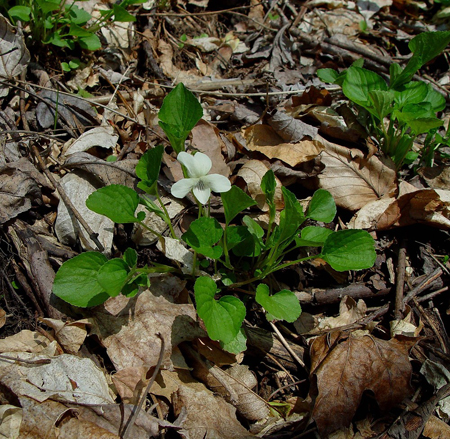
Chasmogamous flowering habit by Arthur Haines, "Go Botany" website, Native Plant Trust
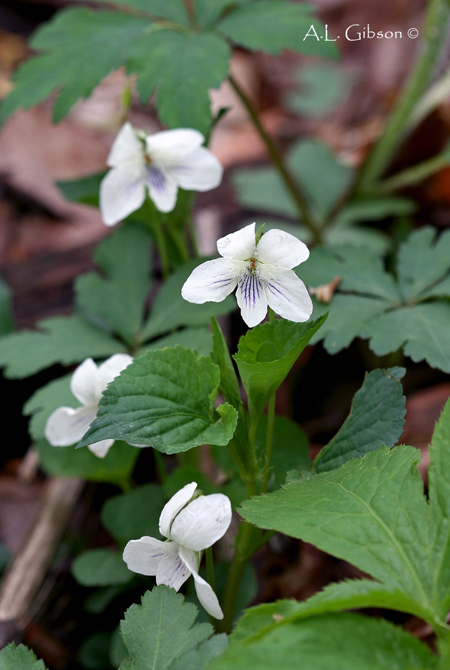
Chasmogamous flowering habit by Andrew Gibson, "Buckeye Botanist" website
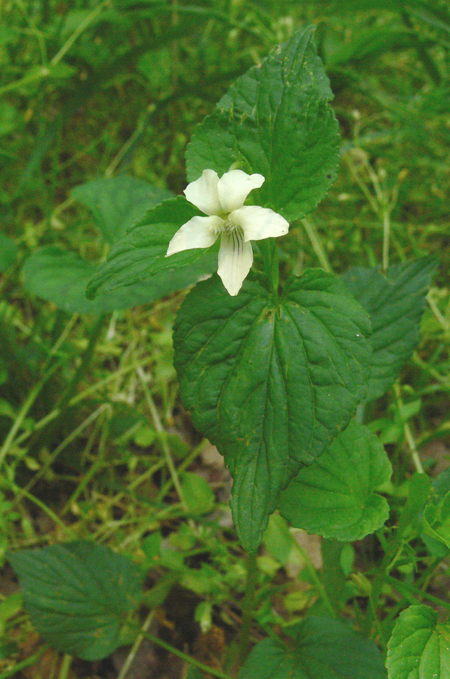
Leaves during chasmogamous flower by Bruce Sorrie
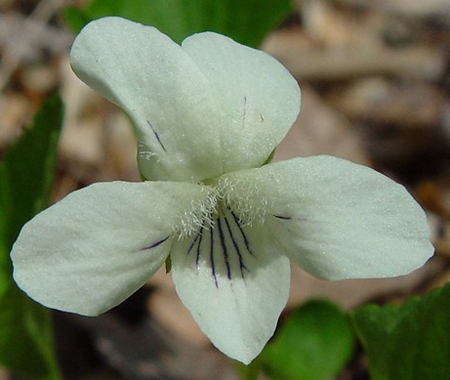
Chasmogamous flower front view by Arthur Haines, "Go Botany" website, Native Plant Trust
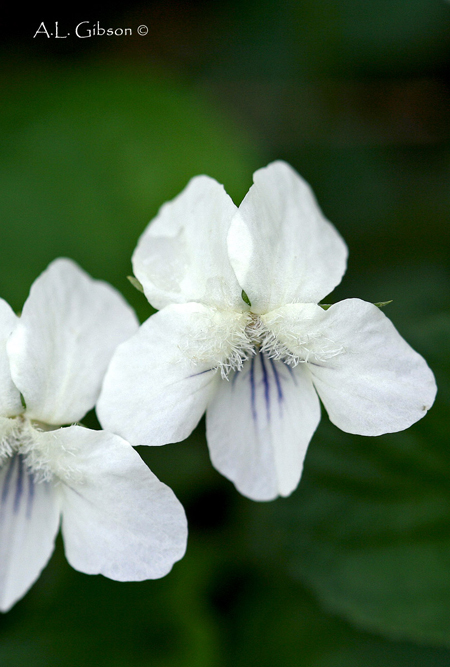
Chasmogamous flower front view by Andrew Gibson, "Buckeye Botanist" website
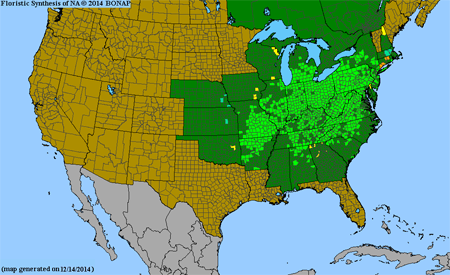
Map by the Biota of North America Program